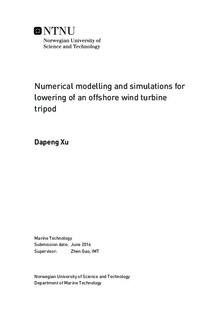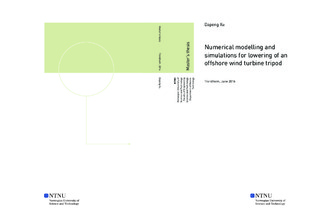| dc.description.abstract | Offshore wind industry is developing very fast. Transport and installation are important aspects
for reducing the life-cycle cost of offshorewind farms. In shallowwaters (10-30mof water
depths), monopile foundations have been widely used, while in deep waters (water depths > 50
m), it is beneficial to use jacket foundations which are transparent to the wave loads. For the
water depths in between, the tripod foundation might be considered due to its simplicity as
well as high stiffness.
This thesis addresses the modelling and dynamic analysis one installation phase for tripods:
the lowering into the sea. Due to non-stationarity, current numerical methods used for steadystate
conditions are not applicable for simulating the lowering phase. In this thesis, timedomain
simulations were performed to account for the responses of the coupled vessel-tripod
system.
A systematic methodology to assess the operational limits based on the installation procedure,
numerical models and safety criteria was introduced. For the tripod lowering process,
the allowable sea states were also established by using the methodology.
These numerical models, methods and dynamic analysis form the basis for assessing the
operational limits for the tripod lowering operation. The operational limits are necessary during
the planning phase of the operation. The allowable sea states together with weather forecasts
provide the basis for the decision making during the execution of the operation. | |

